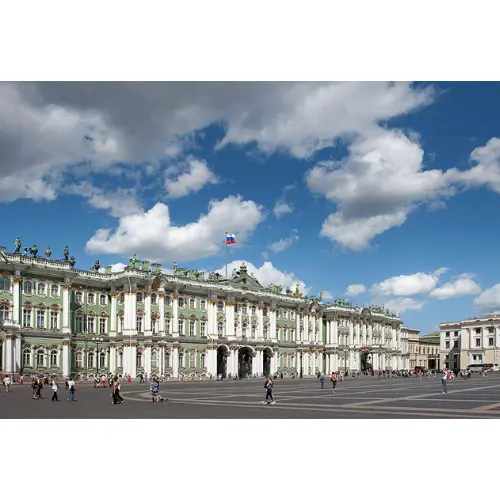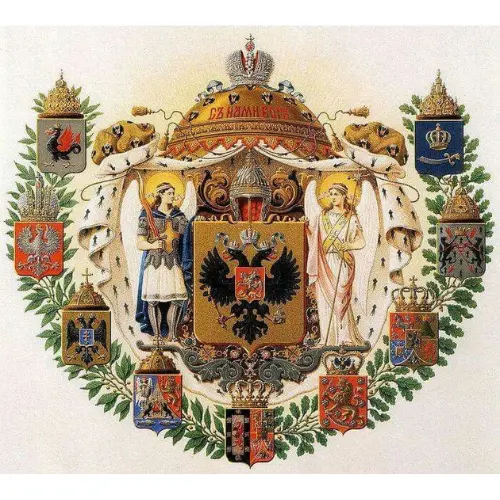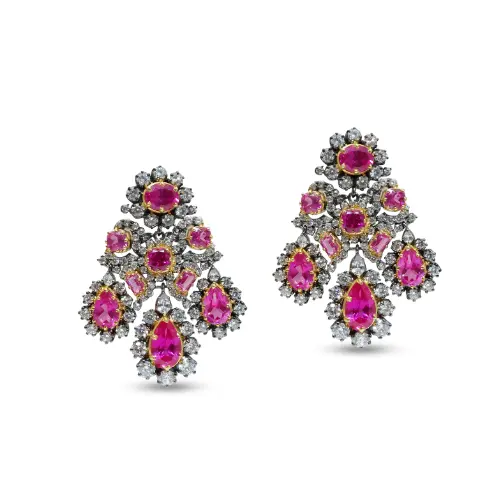The House of Romanov, a name synonymous with opulence, grandeur, and imperial power, stands as one of the most iconic dynasties in the annals of history. For over three centuries, the Romanovs ruled Russia, leaving behind a rich tapestry of history, culture, and exquisite jewelry that continues to captivate the world. In this blog, we delve deep into the history of the Romanov dynasty, exploring their rise to power, the mystique of their jewels, and their ultimate tragic downfall.
The Origins of the Romanov Dynasty
The House of Romanov, originating in the early 17th century, can be traced back to Mikhail Romanov's ascension to the Russian throne in 1613. This marked the conclusion of the Time of Troubles, a tumultuous period of political instability and foreign invasions triggered by a succession crisis. The Time of Troubles saw several pretenders and imposters lay claim to the Russian throne , and witnessed the election of Michael Romanov as Tsar on February 21, 1613, through the Zemsky Sobor assembly. This pivotal moment established the Romanovs as Russia's second reigning dynasty, bringing stability after a turbulent period.

Mikhail Romanov's rule inaugurated a new chapter in Russia's history, with the House of Romanov reigning over the imperial throne for the subsequent three centuries. The Romanovs, led by Mikhail and his successors, played a transformative role, turning Russia into a formidable empire with expanded territorial reach and increased influence across Eastern Europe and Asia.
Golden Age of the Romanovs

One of the most iconic periods in Romanov history was the reign of Peter the Great (1682-1725), who is often credited with modernising and westernising Russia. His rule saw the construction of the magnificent city of St. Petersburg and the creation of a powerful Russian Navy. Peter's expansive vision brought about significant cultural and architectural changes and initiated the transformation of Russia into a European power.
.webp)
Another notable Romanov ruler was Catherine the Great (1762-1796), who oversaw a period of cultural flourishing known as the "Golden Age of the Russian Empire." Her reign witnessed significant territorial expansion and an appreciation for art, culture, and intellectualism. Catherine was a notable patron of the arts and founded the Hermitage Museum in St. Petersburg, which boasts an extensive collection of art, including some pieces from her own collection.
Romanov Jewelry: A Tale of Extravagance and Elegance
The Romanov dynasty was renowned for its extravagant taste in jewelry and gemstones. From crowns to tiaras, necklaces to brooches, the Romanovs possessed an impressive collection of jewels that reflected their opulence and imperial grandeur.
Imperial Regalia:
The Imperial Regalia of Russia comprises a dazzling ensemble of symbols and artifacts that embody the grandeur and authority of the Russian monarchy. This prestigious collection includes the Imperial Crown of Russia, adorned with a large spinel and thousands of diamonds, the Imperial Sceptre, the Orb, and other opulent items. These regalia were integral to the coronation ceremonies of Russian monarchs, symbolizing their divine right to rule and the magnificence of the Russian Empire. Today, these artifacts serve as powerful historical reminders of Russia's imperial past.
The Great Imperial Crown:
The crown jewels of the Romanovs stood out prominently, with the Imperial Crown of Russia being a particularly breathtaking piece. Crafted by jeweler Jérémie Pauzié, this masterpiece was designed for Catherine the Great's coronation in 1762. At its summit is a substantial spinel which weighs nearly 400 carats and has been part of the imperial collection since the seventeenth century, encircled by an astounding 4,936 diamonds, establishing it as an unequivocal emblem of regal authority and prestige.The crown consists of two hemispheres (apparently representing the two halves of the Roman empire), which are edged with 75 white pearls and divided by an elaborate central arch. You’ll note oak leaves and acorns in the garland design of the arch, motifs that represent strength and resilience.

The Imperial Crown of Russia, also known as the Great Imperial Crown, played a pivotal role in the coronation ceremonies of Russian monarchs from 1762 until the dissolution of the Russian monarchy in 1917. Catherine the Great was the first to don this grand imperial crown during her coronation, and its final usage was witnessed at the coronation of Nicholas II. In a notable display, it was presented alongside Nicholas II on a cushion during the State Opening of the Russian Duma in the Winter Palace, St. Petersburg, in 1906. The crown withstood the turbulence of the 1917 revolution and subsequent civil war, finding its current place of exhibition at the Kremlin Armoury's State Diamond Fund in Moscow.
Fabergé Eggs:
The legendary connection between the Romanovs and the House of Fabergé is exemplified through the creation of jeweled eggs by the renowned jewelry firm in Saint Petersburg, Russia. These Fabergé eggs, crafted by Peter Carl Fabergé, are miniature masterpieces presented as Easter gifts to the Romanov family. Recognized as some of the most valuable and beautiful pieces in jewelry history, each egg is a testament to Fabergé's unparalleled craftsmanship, featuring intricate designs, miniature portraits, and concealed surprises. Out of the 69 created, 57 have endured, with nearly all produced under Peter Carl Fabergé's supervision between 1885 and 1917. Notably, the 52 "Imperial" eggs, created for Russian emperors Alexander III and Nicholas II, stand out as the most famous, symbolizing opulence and commanding millions of pounds in value.

The creation known as the Hen Egg, crafted in 1885, draws inspiration from an 18th-century precursor. Resembling a white opaque enamel outer shell, the egg unfolds with a twist, revealing an initial surprise - a matte yellow gold yolk. Nested within is an intricately designed gold hen, which, in its original form, cradled a replica of the Imperial Crown housing a precious ruby pendant egg. Notably, the detachable pendant alone incurred a cost exceeding half of the total price of the entire egg. Unfortunately, both the pendant and the egg are now lost, with their existence solely preserved through an archival photograph.
Romanov Tiaras:
Tiaras held a significant place in the Romanov women's jewelry collections, featuring elegant headpieces adorned with diamonds, pearls, and other precious gems. Noteworthy tiaras from the Romanov collection include the Vladimir Tiara, the Pearl and Diamond Tiara - Empress Alexandra Feodorovna Inspired Drop Pearl tiara , and the Romanov Tiara. Crafted by renowned jewelers of the time, the tiaras and diadems of the Romanov House are considered true works of art and continue to serve as sources of inspiration. During the 1920s, the kokoshnik style gained popularity in Europe, notably worn by brides of European leaders like Mary of Teck, King George V of England's wife.
It's crucial to recognize that all Romanov tiaras and diadems were designed in the distinctive "kokoshnik" style. Historically, a kokoshnik was a headdress worn by married women, characterized by a tall, nimbus, or crest-shaped design tied at the back of the head with long ribbons. The crest often featured intricate embroidery, pearls, and gold, incorporating plant and flower motifs. Pearl netting commonly adorned the forehead area, while women wearing a kokoshnik usually styled their hair in a plait, sometimes combined with the Russian braid. These kokoshnik crowns, adorned with expensive materials such as pearls and beads for lining, were considered valuable family jewels passed down through generations due to their intricate craftsmanship and historical significance.
Personal Jewelry:
In addition to the majestic pieces reserved for official ceremonies, the Romanovs maintained an extensive collection of personal jewelry. Grand duchesses and empresses curated individual assortments of brooches, necklaces, and bracelets, showcasing their distinct tastes and preferences.
The Fall of the Romanov Dynasty

Despite their grandeur and vast wealth, the Romanovs' reign came to a tragic and abrupt end in the early 20th century. The Russian Revolution of 1917 marked the culmination of growing discontent with the autocracy and economic hardships faced by the Russian people.
In February 1917, Tsar Nicholas II abdicated the throne, marking the end of the Romanov dynasty's rule over Russia. The imperial family was placed under house arrest, and they were subsequently moved to various locations, including the Ipatiev House in Yekaterinburg. On July 17, 1918, the Romanov family was executed by Bolsheviks, bringing an end to the dynasty that had ruled Russia for over three centuries.
The tragic fate of the Romanovs has continued to captivate the world's imagination, and their story has been the subject of numerous books, films, and documentaries. In 1991, following the fall of the Soviet Union, the remains of the Romanov family were discovered and eventually interred in the Peter and Paul Cathedral in St. Petersburg.
The Rediscovery of Romanov Jewels
The Romanov jewels were dispersed following the Russian Revolution, and many of them were confiscated by the new Soviet government. Over the years, some pieces were sold or exchanged, while others were preserved in Russian museums and institutions. However, the fate of some of the most prized pieces remains unknown.
One of the most significant discoveries of Romanov jewelry came with the fall of the Soviet Union in the early 1990s. The opening of Russia to the world allowed researchers, historians, and jewelry enthusiasts to explore and document the Romanov jewels that had been stored away in various repositories. This newfound access shed light on the extent of the Romanov jewelry collection and reignited interest in these treasures.
The Legacy of the Romanovs
The Romanovs left behind a profound and enduring legacy, not only in the form of their magnificent jewelry but also in the history and culture of Russia. The House of Romanov's rule contributed to the expansion of the Russian Empire, the transformation of Russian culture, and the promotion of the arts.

The Hermitage Museum in St. Petersburg, Russia, which was founded by Catherine the Great, houses many artworks, including her extensive collection. It serves as a testament to the Romanovs' patronage of the arts and their contributions to Russia's cultural heritage.
The Romanov jewels, though scattered and dispersed over the years, continue to captivate the world. These exquisite pieces are symbols of a bygone era when the Russian Empire was at the height of its power and splendour. Many of these jewels are considered national treasures and hold immense historical and cultural significance.
The House of Romanov, a dynasty that spanned over three centuries and saw the rise and fall of imperial Russia, is a fascinating chapter in world history. The Romanovs' penchant for extravagance is epitomised in their stunning jewelry, which includes crowns, tiaras, Fabergé eggs, and other exquisite pieces. Beyond the jewels, the Romanovs' legacy is deeply embedded in the culture, history, and arts of Russia. While the Romanov dynasty met a tragic end with the Russian Revolution, their story lives on in the museums and institutions that preserve their history and in the continued fascination with their opulent jewels. The House of Romanov remains an enduring symbol of Russia's imperial past, and its legacy continues to shine as brightly as the gems that once adorned its rulers.














